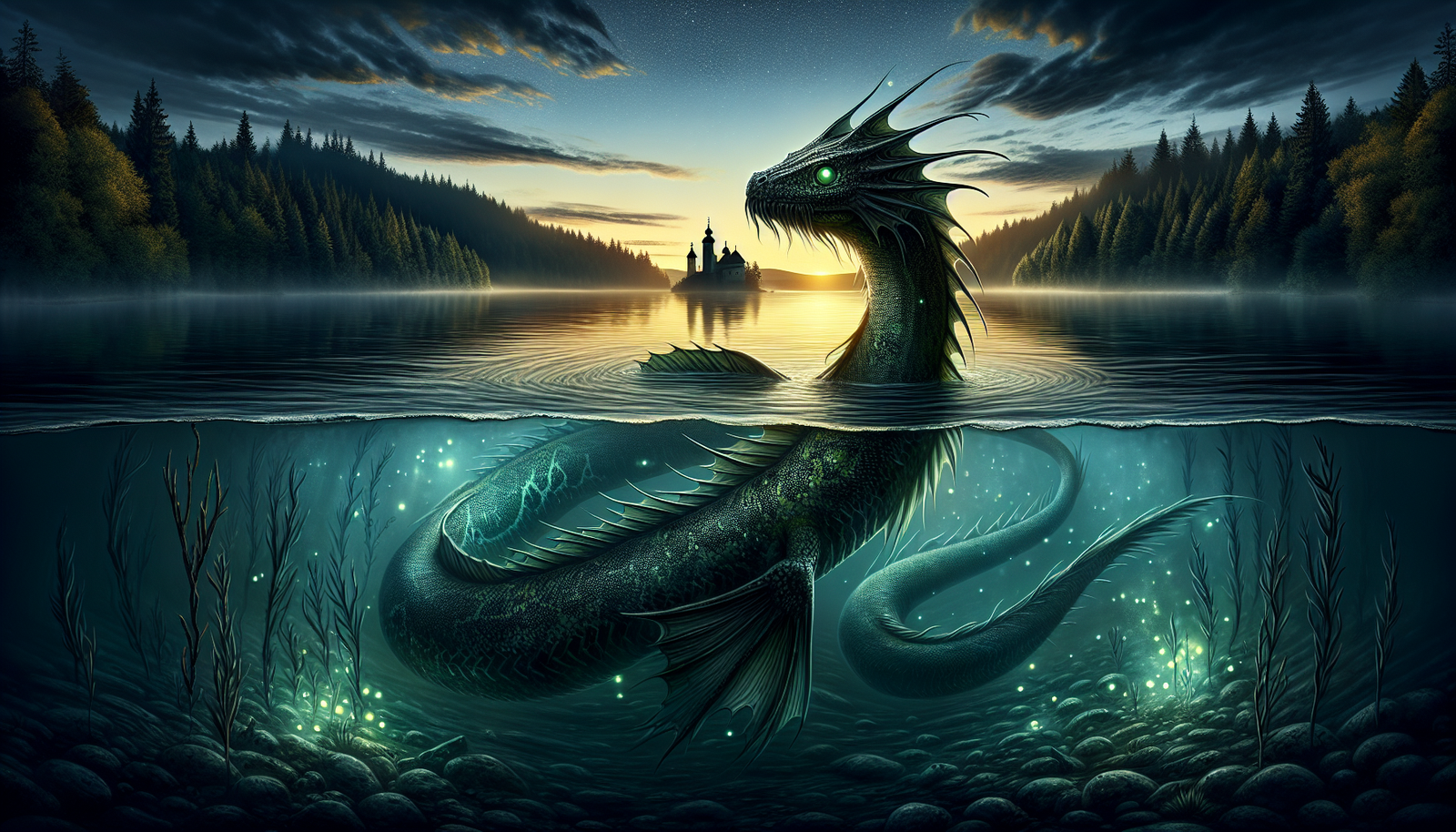The Lake Brosno Dragon: Russia's Nessie

By Jack Sullivan, Cryptozoologist
The allure of lake monsters has long captured the human imagination, weaving its way into the folklore of cultures around the world. From the mist-shrouded lochs of Scotland to the vast, icy expanses of Siberia, tales of mysterious creatures lurking beneath the surface of deep waters have persisted for centuries. These legends speak to something primal within us, a fascination with the unknown and a desire to believe that there are still wonders in this world yet to be discovered.
As a researcher who has dedicated countless hours to the pursuit of cryptids, I've always been drawn to these aquatic enigmas. They represent a unique challenge in the field of cryptozoology, often inhabiting environments that are difficult, if not impossible, for humans to fully explore. The Brosno Dragon, in particular, has caught my attention as a compelling case study in the persistence of legend and the interplay between folklore and scientific inquiry.
Lake Brosno, nestled in the Tver region of Russia, approximately 250 miles northwest of Moscow, is home to this elusive creature. The lake itself is a place of mystery, with depths reaching up to 160 meters in some areas, providing ample space for secrets to hide. As I delved deeper into the lore surrounding the Brosno Dragon, I found myself drawn into a world where ancient tales blend seamlessly with modern sightings, creating a tapestry of intrigue that has captivated locals and researchers alike for generations.
The importance of Lake Brosno in the field of cryptozoology cannot be overstated. While it may not have the global recognition of Loch Ness, the legends surrounding its resident monster offer a unique perspective on how such stories evolve and persist over time. The Brosno Dragon, or Brosnya as it's known locally, represents more than just a potential undiscovered species; it's a cultural touchstone, a source of local pride, and a window into the Russian psyche.
As we embark on this exploration of the Brosno Dragon legend, we'll journey through centuries of history, examining the origins of the tale and how it has evolved over time. We'll look at eyewitness accounts, both ancient and modern, and consider the various theories put forth to explain the phenomenon. From scientific expeditions to local folklore, we'll leave no stone unturned in our quest to understand the enigma of the Brosno Dragon.
In the pages that follow, you can expect a comprehensive analysis of the legend, including:
- A deep dive into the historical context of the Brosno Dragon, tracing its origins back to the 13th century and its connection to significant historical events.
- Detailed descriptions of the creature based on eyewitness accounts, exploring the physical characteristics that have been reported over the years.
- An examination of notable sightings and the impact they've had on local communities and the wider world of cryptozoology.
- A look at scientific investigations into the phenomenon, including the intriguing findings of the 2002 Kosmopoisk expedition.
- An exploration of various theories surrounding the Brosno Dragon, from cryptozoological perspectives to skeptical viewpoints.
- An analysis of the cultural impact of the legend and its place in modern Russian society.
As we unravel the mystery of the Brosno Dragon, I invite you to approach this tale with an open mind. Whether you're a seasoned cryptozoologist or simply someone fascinated by the unknown, there's something in this story for everyone. The legend of the Brosno Dragon serves as a reminder that our world still holds mysteries, and that the intersection of folklore, science, and human belief can create narratives that endure for centuries.
So, let us dive into the depths of Lake Brosno and see what secrets we might uncover. The dragon awaits, and its story is one that deserves to be told.
Historical Context of the Brosno Dragon
Origins of the Legend
As I've learned through my years of researching cryptids, the origins of such legends often stretch back far into the mists of time, blending historical fact with folklore in a way that can be challenging to unravel. The case of the Brosno Dragon is no exception, with its roots reaching deep into Russian history, intertwining with significant events and cultural shifts that have shaped the region.
The first recorded sightings and tales of the Brosno Dragon date back to the 13th century, a time of great turmoil and change in Russian history. It's crucial to understand the context of this period to appreciate how the legend of the dragon took hold in the collective imagination of the people.
In the early 13th century, Russia was a collection of principalities, often at odds with one another and vulnerable to outside threats. The most significant of these threats came in the form of the Mongol invasion, led by Batu Khan, grandson of the infamous Genghis Khan. It was during this tumultuous time that the legend of the Brosno Dragon first emerged, inextricably linked to the fate of the city of Novgorod.
According to the earliest known account, Batu Khan's army was marching towards Novgorod, intent on conquest. As the Mongol forces approached Lake Brosno, they decided to make camp on its shores, allowing their horses to drink from the lake's waters. It was at this moment, as the story goes, that the dragon made its terrifying appearance.
Eyewitness accounts from the time describe a massive creature emerging from the depths of the lake, its roar echoing across the water. The beast, with its serpentine body and fearsome jaws, began to attack the Mongol horses and soldiers, creating chaos and panic among the invading force. The sight of this monstrous creature was so terrifying that Batu Khan and his army reportedly abandoned their plans to attack Novgorod, turning back and sparing the city from destruction.
This tale, blending historical fact with legendary elements, serves as the foundation for the Brosno Dragon myth. It's a classic example of how cryptid legends often arise, attaching themselves to significant historical events and providing explanations for outcomes that might otherwise seem inexplicable.
The connection to Batu Khan and the Mongol invasion is particularly significant. The Mongol conquest of Russia was a defining moment in the country's history, leaving deep scars on the national psyche. The idea that a local monster could have played a role in turning back this fearsome enemy would have been incredibly appealing to the people of the region, offering a sense of pride and divine protection in the face of overwhelming odds.
It's worth noting that while this is the earliest recorded mention of the Brosno Dragon, it's likely that tales of a creature inhabiting the lake predated this event. Lakes and rivers have long been associated with mythical beasts in cultures around the world, and it's probable that local folklore already included stories of a lake monster before the Mongol invasion. The dramatic encounter with Batu Khan's army would have served to solidify these pre-existing beliefs, giving them a historical anchor and elevating the dragon from local legend to national myth.
As a researcher, I find this origin story fascinating not just for its historical significance, but for what it tells us about the human need to create narratives that explain the world around us. The Brosno Dragon, in this context, becomes more than just a potential cryptid; it's a symbol of resistance against foreign invasion, a protector of the Russian people, and a testament to the power of nature in the face of human aggression.
This initial legend set the stage for centuries of sightings and stories, each building upon the last to create the rich tapestry of lore that surrounds the Brosno Dragon today. As we continue to explore the evolution of this legend, we'll see how these early tales influenced later sightings and shaped the way people interacted with Lake Brosno and its mysterious inhabitant.
Evolution of the Legend
The story of the Brosno Dragon, like many cryptid legends, has not remained static over the centuries. Instead, it has evolved, adapting to changing cultural contexts and incorporating new elements as time has passed. This evolution is a fascinating study in how folklore persists and transforms, reflecting the values and fears of each successive generation.
Following the initial tales of the dragon's encounter with Batu Khan's army, the legend continued to grow and change. Throughout the medieval period, stories of the Brosno Dragon became intertwined with other aspects of local folklore. Fishermen told tales of boats being overturned by a massive creature, while others spoke of hearing strange noises emanating from the depths of the lake.
One particularly intriguing story from this period tells of a group of Varangian (Viking) mercenaries who attempted to hide stolen treasure on a small island in Lake Brosno. As they approached the island, the dragon is said to have emerged from the water, swallowing the entire island whole and thwarting the thieves' plans. This tale not only adds to the dragon's fearsome reputation but also introduces a moral element to the legend, suggesting that the creature might act as a sort of supernatural guardian against wrongdoing.
As Russia entered the modern era, the legend of the Brosno Dragon continued to adapt. In the 18th and 19th centuries, sightings became more frequent, or at least more frequently recorded. These accounts often described the creature as emerging in the evenings, only to quickly submerge when approached by humans. This pattern of behavior, similar to that reported in other lake monster sightings around the world, helped to cement the Brosno Dragon's place in the pantheon of cryptid lore.
The 20th century brought new dimensions to the legend. During World War II, a particularly outlandish tale emerged claiming that the Brosno Dragon had swallowed a German airplane whole. While this story is almost certainly apocryphal, it demonstrates how the legend continued to be adapted to fit current events, with the dragon once again cast in the role of protector against foreign invaders.
In more recent years, the legend has taken on new life in the age of mass media and internet communication. Sightings are now quickly shared online, allowing for greater scrutiny but also wider dissemination of the legend. The Brosno Dragon has become a topic of interest for cryptozoologists and monster hunters from around the world, drawing comparisons to other lake monsters like the Loch Ness Monster and Ogopogo.
The role of oral tradition in shaping the Brosno Dragon narrative cannot be overstated. For centuries, the legend was passed down through generations of local residents, each retelling adding new details and nuances to the story. This oral tradition has helped to keep the legend alive, even in the face of skepticism and scientific inquiry.
One of the most interesting aspects of the legend's evolution is how the description of the creature has changed over time. Early accounts often described the dragon in more traditional, mythical terms, emphasizing its serpentine nature and ability to breathe fire. As the years passed, and particularly in the 20th century, descriptions began to align more closely with the idea of a prehistoric survivor, similar to the plesiosaur theory popular among Loch Ness Monster enthusiasts.
This shift in description reflects changing cultural attitudes and increased scientific knowledge. As the concept of dinosaurs and prehistoric creatures became more widely understood, it was natural for people to interpret the Brosno Dragon through this lens. The idea of a surviving prehistoric reptile seemed more plausible, or at least more aligned with modern sensibilities, than a traditional fire-breathing dragon.
Another interesting development in the legend is the attribution of bioluminescent properties to the creature. Some modern accounts describe the Brosno Dragon as glowing or having a strange iridescence, a feature not mentioned in earlier tales. This could be seen as an attempt to explain how the creature might be spotted in the often murky waters of Lake Brosno, or it could be influenced by discoveries of bioluminescent creatures in the deep ocean.
The evolution of the Brosno Dragon legend also reflects changing attitudes towards the natural world. In earlier times, the dragon was often portrayed as a fearsome, dangerous creature, a threat to those who ventured too close to the lake. More recent accounts, however, sometimes depict the dragon in a more sympathetic light, as a rare and potentially endangered creature worthy of protection.
This shift mirrors broader changes in environmental consciousness and attitudes towards wildlife conservation. The idea of the Brosno Dragon as the last of its kind, struggling to survive in a changing world, resonates with modern concerns about biodiversity and habitat loss.
As a researcher, I find the evolution of the Brosno Dragon legend to be a fascinating case study in how cryptid lore adapts and persists over time. It demonstrates the resilience of these stories, their ability to change with the times while still maintaining their core appeal. The Brosno Dragon, whether real or imaginary, continues to capture the imagination of people around the world, a testament to the enduring power of mystery and the unknown.
Cultural Significance
The Brosno Dragon, like many cryptids, has transcended its status as a mere legend to become an integral part of the cultural fabric of the region. Its significance extends far beyond the realm of folklore, influencing local identity, tourism, and even scientific inquiry. As someone who has studied the impact of cryptid legends on communities, I find the cultural role of the Brosno Dragon particularly fascinating.
One of the most interesting aspects of the Brosno Dragon legend is its portrayal as a protector of Novgorod. This aspect of the story, dating back to the earliest known accounts of the creature's encounter with Batu Khan's army, has had a profound impact on how the dragon is perceived by local people. Rather than being seen solely as a fearsome monster, the Brosno Dragon has taken on the role of a guardian spirit, a supernatural defender of the Russian people against outside threats.
This protective aspect of the dragon's mythology bears similarities to other legendary creatures around the world. In Chinese folklore, for example, dragons are often seen as benevolent beings associated with wisdom and strength. The idea of a powerful creature acting as a protector of a specific place or people is a common theme in mythology, and the Brosno Dragon fits neatly into this tradition.
The cultural significance of the Brosno Dragon extends beyond its role in folklore. For the communities surrounding Lake Brosno, the legend has become a source of local pride and identity. The dragon serves as a unique cultural marker, distinguishing the region from other parts of Russia and giving residents a sense of connection to something ancient and mysterious.
This sense of pride is evident in the way the legend is celebrated and promoted locally. The Brosno Dragon has inspired local art, literature, and even tourism initiatives. Souvenirs featuring depictions of the dragon are popular among visitors to the region, and local businesses often incorporate references to the legend in their names or marketing materials.
The impact on tourism should not be underestimated. While Lake Brosno may not have the international recognition of Loch Ness, it has become a draw for cryptid enthusiasts and curious tourists alike. This influx of visitors provides economic benefits to the local community, creating jobs and supporting businesses. The legend of the Brosno Dragon has, in essence, become a valuable cultural resource for the region.
From an academic perspective, the Brosno Dragon legend offers valuable insights into Russian folklore and cultural history. The way the legend has evolved over time reflects changing attitudes and beliefs in Russian society. For example, the dragon's role in turning back the Mongol invasion speaks to the historical trauma of that period and the desire for a narrative of resistance and protection.
The Brosno Dragon also serves as an interesting point of comparison with other lake monsters in global folklore. While it shares some similarities with creatures like the Loch Ness Monster or Lake Champlain's Champ, it also has unique characteristics that set it apart. These differences and similarities can provide valuable insights into how cryptid legends develop in different cultural contexts.
One particularly interesting aspect of the Brosno Dragon's cultural significance is its role in environmental awareness. The legend has helped to foster a sense of stewardship over Lake Brosno and its surrounding ecosystem. People who believe in the dragon's existence, or even those who simply appreciate the legend, often feel a stronger connection to the lake and a desire to protect it. This has led to increased interest in the lake's ecology and efforts to preserve its natural beauty.
The legend has also had an impact on scientific research in the region. While many scientists remain skeptical of the dragon's existence, the persistent reports of sightings have sparked interest in studying Lake Brosno's unique ecosystem. This has led to valuable research on the lake's geology, biology, and water chemistry, contributing to our understanding of freshwater ecosystems in general.
In the realm of cryptozoology, the Brosno Dragon holds a special place. While it may not have the global fame of Nessie, it is well-known among enthusiasts and researchers in the field. The dragon serves as an important case study in how cryptid legends persist and evolve over time, and how they interact with local culture and belief systems.
The cultural significance of the Brosno Dragon extends even to the realm of psychology and sociology. The persistence of belief in the creature, despite a lack of conclusive evidence, offers insights into human psychology and the need for mystery and wonder in our lives. It raises questions about the role of folklore in modern society and how traditional beliefs coexist with scientific understanding.
As a researcher, I find the Brosno Dragon to be a compelling example of how cryptid legends can become deeply intertwined with local culture and identity. Whether or not the dragon actually exists, its impact on the region is undeniable. The legend has shaped how people relate to Lake Brosno, influenced local economy and tourism, and contributed to the rich tapestry of Russian folklore.
The Brosno Dragon serves as a reminder that legends and folklore are not mere relics of the past, but living, evolving aspects of culture that continue to shape our world in tangible ways. As we continue to explore the mystery of the Brosno Dragon, it's important to remember that its significance extends far beyond the question of its physical existence. The dragon lives in the stories, beliefs, and cultural practices of the people who call the shores of Lake Brosno home, and in doing so, it has achieved a kind of immortality that few creatures, real or imagined, ever attain.
Descriptions and Sightings
Physical Characteristics
As a researcher who has spent countless hours poring over eyewitness accounts and historical records, I've come to realize that one of the most fascinating aspects of cryptid studies is the way descriptions of these elusive creatures evolve over time. The Brosno Dragon is no exception, with reports of its appearance varying widely over the centuries. However, certain common threads emerge that allow us to paint a picture of this mysterious beast.
The most consistent description of the Brosno Dragon portrays it as a large, serpentine creature, often compared to a giant snake or eel. Eyewitnesses frequently report seeing a long, sinuous body moving through the water, creating significant disturbances on the lake's surface. The length of the creature is typically estimated to be between 13 and 16 feet (4-5 meters), though some accounts suggest it could be even larger.
One of the most distinctive features reported is the creature's head. Many witnesses describe seeing a head that rises above the water's surface, often compared to that of a snake or a fish. The head is usually described as being relatively small in proportion to the body, with some accounts mentioning large, expressive eyes. Interestingly, there are variations in the descriptions of the head shape, with some reports suggesting a more elongated, almost horse-like appearance, while others describe it as more rounded or fish-like.
The skin or outer covering of the Brosno Dragon is another point of interest in eyewitness accounts. Many reports describe the creature as having a dark coloration, often described as black, dark green, or dark gray. Some witnesses have reported seeing scales or a rough, textured skin, similar to that of a reptile. However, it's worth noting that these details can be difficult to discern, especially when the creature is observed from a distance or in low light conditions.
One of the most intriguing aspects of the Brosno Dragon's reported appearance is the mention of fins or flippers. While not present in all accounts, a significant number of witnesses have described seeing appendages that the creature uses to propel itself through the water. These are often compared to the flippers of a seal or the fins of a fish, suggesting a creature well-adapted to an aquatic environment.
Perhaps the most unusual and controversial aspect of the Brosno Dragon's reported appearance is the claim of bioluminescence or iridescence. Some modern accounts describe the creature as having a strange glow or shimmering quality to its skin. This feature is not mentioned in earlier historical accounts, which raises interesting questions about how and why this detail has been added to the creature's description in recent years.
It's important to note that the reported physical characteristics of the Brosno Dragon have evolved over time. Early accounts, particularly those from the medieval period, often described the creature in more mythical terms, sometimes even attributing to it the ability to breathe fire or possess multiple heads, much like dragons in European folklore. As time progressed, and particularly in the 20th and 21st centuries, descriptions have tended to become more naturalistic, aligning more closely with the idea of an unknown species of aquatic animal rather than a mythical beast.
This evolution in description could be attributed to several factors. Increased scientific knowledge and a greater understanding of zoology may have influenced how people interpret and report their sightings. The global popularity of other lake monster legends, particularly that of the Loch Ness Monster, may have also played a role in shaping expectations and interpretations of what a lake monster "should" look like.
One particularly interesting aspect of the Brosno Dragon's reported physical characteristics is the lack of consistency in some details. While the general shape and size of the creature remain fairly constant across accounts, details such as the presence or absence of a visible mouth, the exact shape of the head, or the nature of any fins or appendages can vary widely. This inconsistency is not uncommon in cryptid reports and can be attributed to a variety of factors, including differences in viewing conditions, the brief and often startling nature of encounters, and the natural variations in human perception and memory.
It's also worth considering the potential influence of local wildlife on descriptions of the Brosno Dragon. Lake Brosno is home to a variety of fish species, including large specimens of pike and burbot. In some cases, sightings of unusually large fish or groups of fish moving together could potentially be misinterpreted as a single, larger creature, especially under poor visibility conditions.
The reported size of the Brosno Dragon is another point of interest. While most accounts describe a creature in the 13-16 foot range, there are some outlying reports of much larger beasts. These extreme size estimates should be treated with caution, as size estimation, particularly on water and at a distance, can be notoriously unreliable. However, the consistency with which the creature is described as being significantly larger than any known species in the lake does lend some weight to the idea that, if it exists, the Brosno Dragon represents an unknown large animal.
One aspect of the Brosno Dragon's reported physical characteristics that sets it apart from many other lake monsters is the occasional mention of it being able to move on land. While not a common feature of the legend, there are a few accounts that describe the creature emerging from the lake and moving on the shore. This amphibious quality, if true, would make the Brosno Dragon quite unique among lake cryptids and raise interesting questions about its possible identity and evolutionary history.
The reported physical characteristics of the Brosno Dragon present a fascinating puzzle for cryptozoologists and researchers. The creature, as described by eyewitnesses, doesn't neatly fit into any known category of animal. Its serpentine body and aquatic lifestyle suggest some form of giant eel or snake, yet the reported presence of fins or flippers complicates this interpretation. The occasional reports of bioluminescence add another layer of mystery, as this trait is rare in freshwater creatures.
As a researcher, I find these descriptions both intriguing and challenging. On one hand, the consistency in certain aspects of the creature's appearance across numerous independent accounts suggests that there may indeed be something unusual in Lake Brosno. On the other hand, the variations and inconsistencies in the reports make it difficult to form a clear picture of what this creature, if it exists, might actually be.
What's clear is that the physical descriptions of the Brosno Dragon, whether based on actual sightings of an unknown animal or shaped by cultural expectations and misidentifications, have played a crucial role in shaping the legend. These descriptions have captured the imagination of locals and visitors alike, fueling continued interest in the mystery of Lake Brosno and ensuring that the legend of the dragon continues to thrive in the modern era.
Notable Sightings
Throughout my years of researching cryptids, I've learned that the heart of any legend lies in the sightings reported by eyewitnesses. The Brosno Dragon is no exception, with a rich history of encounters that span centuries. These sightings, ranging from ancient tales to modern-day reports, form the backbone of the legend and provide valuable insights into how the story of the dragon has evolved over time.
One of the earliest and most famous sightings, as we've discussed, is the legendary encounter with Batu Khan's army in the 13th century. While this event is more myth than documented history, it set the stage for centuries of reported sightings to come. In the following centuries, numerous accounts emerged from local fishermen and residents living near Lake Brosno.
A particularly intriguing series of sightings occurred in the 18th and 19th centuries. During this period, there were frequent reports of a large creature surfacing in the evenings, only to quickly submerge when approached. These sightings often described a long neck emerging from the water, sometimes accompanied by a humped back breaking the surface. The consistency of these reports over an extended period lends credibility to the idea that something unusual was indeed being seen in the lake.
One notable sighting from the early 20th century comes from a group of fishermen who claimed to have seen the creature up close. According to their account, they were out on the lake in the early morning when a large, dark shape surfaced near their boat. They described seeing a head "like a horse but scaly" rise out of the water, followed by a long neck. The creature reportedly eyed them for a moment before sinking back into the depths, leaving the fishermen shaken but unharmed.
During World War II, an outlandish but widely circulated story emerged claiming that the Brosno Dragon had swallowed a German airplane whole. While this tale is almost certainly apocryphal, it demonstrates how the legend continued to capture the public imagination and adapt to current events. It also shows how the dragon's reputation as a protector against foreign invaders, established in the earliest legends, continued to be reinforced.
In the post-war years, sightings continued, often reported by tourists visiting the area. One particularly interesting account comes from a family vacationing near the lake in the summer of 1966. They reported seeing a large, dark shape moving through the water, creating a significant wake. What makes this sighting notable is that multiple family members saw the creature, providing corroborating testimonies.
Perhaps one of the most significant modern sightings occurred in 1996 when a family of tourists from Moscow claimed to have photographed the creature. According to their account, they were walking along the shore when their young son shouted that he saw a dragon in the water. The father quickly snapped a photo, which shows a dark, elongated shape in the water. While the image is blurry and inconclusive, it sparked renewed interest in the Brosno Dragon and led to increased media attention.
In the early 2000s, there was a flurry of reported sightings, coinciding with increased interest in the legend. Local newspapers began to regularly feature stories about the dragon, often accompanied by sketches based on eyewitness descriptions. One particularly detailed account from 2002 described a creature with a long neck, a horse-like head, and a body that seemed to glow faintly in the dark waters.
These modern sightings have had a significant impact on local communities. They have reignited interest in the legend, attracting tourists and researchers to the area. Local businesses have capitalized on the renewed attention, offering Brosno Dragon-themed souvenirs and boat tours of the lake. The sightings have also sparked debate among locals, with some firmly believing in the creature's existence while others remain skeptical.
From a research perspective, these sightings provide valuable data for analysis. The consistency in certain details across multiple independent accounts is particularly interesting. The creature is almost always described as being significantly larger than any known species in the lake, with estimates ranging from 13 to 30 feet in length. The serpentine body, long neck, and horse-like or fish-like head are also common elements in many reports.
However, it's important to approach these sightings with a critical eye. Many factors can influence what people perceive and how they interpret their experiences. Misidentification of known animals, optical illusions caused by waves or floating debris, and the power of suggestion in an area known for its monster legend can all play a role in shaping these accounts.
The reliability of eyewitness testimony is a complex issue in cryptozoology. While multiple consistent reports can lend credibility to a phenomenon, human perception is notoriously fallible, especially in unfamiliar or stressful situations. Factors such as distance, lighting conditions, and the often brief nature of these encounters can all affect how accurately a witness recalls and describes what they've seen.
Moreover, the cultural context in which these sightings occur cannot be ignored. The long-standing legend of the Brosno Dragon creates an expectation that may influence how people interpret unusual sights or sounds on the lake. This doesn't necessarily mean that all sightings are misidentifications or hoaxes, but it does underscore the need for careful, critical analysis of each report.
One interesting trend in the sightings of the Brosno Dragon is the evolution of the descriptions over time. Early accounts often described the creature in more mythical terms, sometimes attributing supernatural abilities to it. As time progressed, and particularly in the 20th and 21st centuries, the descriptions have tended to become more naturalistic, aligning more closely with the idea of an unknown species of aquatic animal rather than a mythical beast.
This shift could reflect changing cultural attitudes and increased scientific knowledge, but it also makes the legend of the Brosno Dragon more compelling to modern audiences. The idea of a relict population of prehistoric creatures surviving in a remote lake is more palatable to the modern mind than tales of fire-breathing dragons.
The impact of these sightings extends beyond mere curiosity. They have shaped local culture, influenced tourism, and even spurred scientific investigation of Lake Brosno. The 2002 expedition by the Kosmopoisk research association, which used sonar to search for evidence of large creatures in the lake, was directly inspired by the persistent reports of sightings.
While no definitive proof of the Brosno Dragon has been found, these sightings continue to fuel interest in the legend. They serve as a reminder that our world still holds mysteries, and that the unknown continues to captivate the human imagination. Whether the Brosno Dragon is a real, undiscovered creature, a case of mistaken identity, or a product of cultural mythology, the sightings themselves are a fascinating study in how legends persist and evolve in the modern world.
As a researcher, I find these sightings to be a valuable resource in understanding not just the potential existence of unknown animals, but also the ways in which humans interact with the unknown. They provide insights into perception, memory, and the power of suggestion, as well as the role that legends and folklore play in shaping our interpretation of the world around us.
From Bigfoot to UFOs: Hangar 1 Publishing Has You Covered!
Explore Untold Stories: Venture into the world of UFOs, cryptids, Bigfoot, and beyond. Every story is a journey into the extraordinary.
Immersive Book Technology: Experience real videos, sights, and sounds within our books. Its not just reading; its an adventure.



























